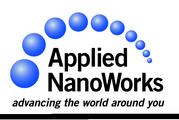Home > Press > Applied NanoWorks Develops FlexBTM Flame Retardant: Achieves UL-94 V-0 Ratings at Low-Load Levels
 |
Abstract:
Applied NanoWorks (ANW), an inorganic materials development company, has announced FlexB™, a boron-based, non-halogenated flame retardant (FR) additive for nylon, epoxies and water-based coatings. Material testing has achieved UL-94 V-0 ratings with FlexB loading levels as low as 3%.
Applied NanoWorks Develops FlexBTM Flame Retardant: Achieves UL-94 V-0 Ratings at Low-Load Levels
MALTA, NY | Posted on February 10th, 2009"FlexB™ is targeted at high-performance materials where traditional high load levels negatively affect weight, strength and other physical attributes," said Josh Kunkel, Business Development Manager at ANW. "FlexB™ addresses the industry need for non-halogenated flame-resistance while keeping polymer performance at optimized levels."
With increasingly stringent government regulation and consumer demand for more environmentally friendly materials, the plastics and coatings industries are seeking non-halogenated low-load fire retardants. "In many applications halogenated FR additives are just not an option anymore," Kunkel noted.
Engineering plastics, commonly used in automotive and electrical applications, often must meet UL-94 V-0 flammability ratings. Many current FR additives require loading levels as high as 20-30% to meet this standard, impacting the processability, rheology and mechanical properties of the material. The ability of the FlexB™ FR additive to achieve UL-94 V-0 ratings at load levels as low as 3% provides flexibility in material performance and selection.
"FlexB™ has shown increased flame retardancy over traditional FR additives by as much as 10X," stated Kyle Litz, Chief Technology Officer at ANW. "This increase is due to the ability of FlexB to bind into the backbone of the polymer, providing four levels of protection: off-gassing, water productions, charring and thermal shielding. This is a significant advancement over current flame retardant additives that are simply mixed in with the polymer."
The FlexB™ flame retardant additive, developed using Applied NanoWorks' MCP Technology™ platform, is designed to deliver specific performance gains to material systems requiring flame retardants. Due to the increased inorganic functionality derived from MCP Technology™ FlexFR flame retardant additives are a fundamentally simpler way to add FR characteristics to polymers.
The Underwriters Laboratories Inc. UL-94 program defines the Standard for Flammability of Plastic Materials for Parts in Devices and Appliances. The UL-94 V-0 classification relates to materials commonly used in manufacturing enclosures, structural parts and insulators found in consumer electronic products.
####
About Applied NanoWorks (ANW)
Applied NanoWorks is an inorganic materials development company focused on creating inorganics that provide new levels of performance required to build successful material systems for a clean tech world.
For more information, please click here
Contacts:
Eric Burnett
President & CEO
Applied NanoWorks, Inc.
518.899.9600 ext 110
Copyright © Marketwire
If you have a comment, please Contact us.Issuers of news releases, not 7th Wave, Inc. or Nanotechnology Now, are solely responsible for the accuracy of the content.
| Related News Press |
News and information
![]() Simulating magnetization in a Heisenberg quantum spin chain April 5th, 2024
Simulating magnetization in a Heisenberg quantum spin chain April 5th, 2024
![]() NRL charters Navy’s quantum inertial navigation path to reduce drift April 5th, 2024
NRL charters Navy’s quantum inertial navigation path to reduce drift April 5th, 2024
![]() Discovery points path to flash-like memory for storing qubits: Rice find could hasten development of nonvolatile quantum memory April 5th, 2024
Discovery points path to flash-like memory for storing qubits: Rice find could hasten development of nonvolatile quantum memory April 5th, 2024
Materials/Metamaterials/Magnetoresistance
![]() Nanoscale CL thermometry with lanthanide-doped heavy-metal oxide in TEM March 8th, 2024
Nanoscale CL thermometry with lanthanide-doped heavy-metal oxide in TEM March 8th, 2024
![]() Focused ion beam technology: A single tool for a wide range of applications January 12th, 2024
Focused ion beam technology: A single tool for a wide range of applications January 12th, 2024
Announcements
![]() NRL charters Navy’s quantum inertial navigation path to reduce drift April 5th, 2024
NRL charters Navy’s quantum inertial navigation path to reduce drift April 5th, 2024
![]() Discovery points path to flash-like memory for storing qubits: Rice find could hasten development of nonvolatile quantum memory April 5th, 2024
Discovery points path to flash-like memory for storing qubits: Rice find could hasten development of nonvolatile quantum memory April 5th, 2024
|
|
||
|
|
||
| The latest news from around the world, FREE | ||
|
|
||
|
|
||
| Premium Products | ||
|
|
||
|
Only the news you want to read!
Learn More |
||
|
|
||
|
Full-service, expert consulting
Learn More |
||
|
|
||








